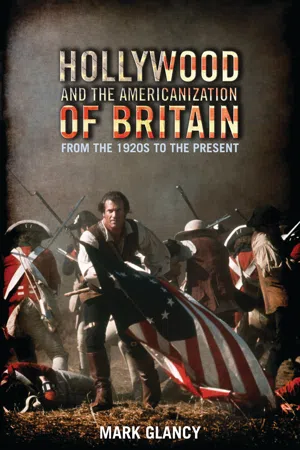![]()
Notes
Introduction
1. See, for example, Genevieve Abravanel, Americanizing Britain: The Rise of Modernism in the Age of the Entertainment Empire (Oxford: Oxford University, 2012); Margaret Dickinson and Sarah Street, Cinema and State: The Film Industry and the British Government (London: British Film Institute, 1985); Ian Jarvie, Hollywood’s Overseas Campaign: The North Atlantic Movie Trade, 1920–50 (Cambridge: Cambridge University Press, 1992); Tom Ryall, Britain and the American Cinema (London: Sage, 2001); Paul Swann, The Hollywood Feature Film in Postwar Britain (London: Croom Helm, 1987); John Trumpbour, Selling Hollywood to the World: US and European Struggles for Mastery of the Global Film Industry (Cambridge: Cambridge University Press, 2002); and Duncan Webster, Looka Yonder: The Imaginary America of Populist Culture (London: Routledge, 1988).
2. Sean Perkins relates that in 1946, the peak year of cinema-going in Britain, 1.6 billion cinema tickets were sold, which represents an average of 36 tickets per person in that year. In 2010, feature films were watched on 4.6 billion occasions, which represents an average of 81 films watched per person in that year. The comparison should be regarded as a rough one, though, especially as cinema-goers often saw more than one feature film in a single visit to the cinema in the 1940s. See Sean Perkins, ‘Film in the UK, 2001–10: A Statistical Overview’, Journal of British Cinema and Television 9/3 (2012), pp. 310–12.
3. Geoffrey Nowell-Smith, ‘But Do We Need It?’, in Martyn Auty and Nick Roddick (eds), British Cinema Now (London: British Film Institute, 1985), pp. 151–52.
4. Ryan Gilbey (ed.), The Ultimate Film: The UK’s 100 Most Popular Films (London: British Film Institute, 2005).
5. See especially Melvyn Stokes and Richard Maltby (eds), Hollywood Abroad: Audiences and Cultural Exchange (London: British Film Institute, 2004); and Sarah Street, Transatlantic Crossings: British Feature Films in the USA (London: Continuum, 2002).
6. Andrew Higson, ‘The Concept of National Cinema’, Screen 30/4 (1989), p. 37.
7. Victoria de Grazia, ‘Mass Culture and Sovereignty: The American Challenge to European Cinemas, 1920–60’, Journal of Modern History 61/1 (1989), p. 53.
8. For a wider examination of ideas of national decline, and one that traces the concept back to the nineteenth century, see the essay entitled ‘Statecraft: The Haunting Fear of National Decline’, in David Cannadine, In Churchill’s Shadow: Confronting the Past in Modern Britain (London: Allen Lane, 2002), pp. 26–44.
9. Helen Taylor, Scarlett’s Women: Gone with the Wind and its Female Fans (London: Virago, 1987); and Jackie Stacey, Star Gazing: Hollywood Cinema an Female Spectatorship (London: Routledge, 1994).
10. Annette Kuhn, An Everyday Magic: Cinema and Cultural Memory (London: I.B.Tauris, 2002).
11. Another book that might be considered here is Thomas Austin’s Hollywood, Hype and Audiences: Selling and Watching Popular Films in the 1990s (Manchester: Manchester University Press, 2002). Like Taylor and Stacey, Austin also used questionnaires to seek British audience responses to popular Hollywood films, albeit of a much more recent vintage. But while Austin’s research highlights important aspects of reception study (notably the impact of marketing and publicity on audience responses), he is largely unconcerned by the transnational dimensions of his study.
12. Janet Staiger, Interpreting Films: Studies in Historical Reception of American Cinema (Princeton, NJ: Princeton University Press, 1992).
13. This argument is made most forcefully in Janet Staiger, ‘“The Handmaiden of Villainy”: Methods and Problems in Studying the Historical Reception of a Film’, Wide Angle 8/1 (1986), p. 21. It is also made, with less specific reference to audience research, in Staiger’s Interpreting Films, pp. 79–80.
14. See, for example, Richard Weight, Patriots: National Identity in Britain, 1940–2000 (London: Macmillan, 2002), p. 88.
15. Staiger: Interpreting Films, p. 93; and Barbara Klinger, ‘Film History Terminable and Interminable: Recovering the Past in Reception Studies’, Screen 38/2 (1997), pp. 107–28.
16. Klinger: ‘Film History Terminable and Interminable’, p. 111.
17. Richard Maltby, ‘Introduction: The Americanisation of the World’, in Melvyn Stokes and Richard Maltby (eds), Hollywood Abroad: Audiences and Cultural Exchange (London: British Film Institute, 1994), pp. 2–3.
18. Michael Hammond, The Big Show: British Cinema Culture in the Great War, 1914–1918 (Exeter: Exeter University Press, 2006), p. 4.
19. Harper’s studies concern the Regent Cinema, Portsmouth, in the 1930s and 1940s; see ‘A Lower Middle-Class Taste Community in the 1930s: Admissions Figures at the Regent Cinema, Portsmouth, UK’, Historical Journal of Film, Radio and Television 24/4 (2004), pp. 565–87; and ‘Fragmentation and Crisis: 1940s Admissions Figures at the Regent Cinema, Portsmouth, UK’, Historical Journal of Film, Radio and Television 26/3 (2006), pp. 361–94. Poole’s study concerns the Majestic Cinema, Macclesfield; see Julian Poole, ‘British Cinema Attendance in Wartime: Audience Preference at the Majestic, Macclesfield, 1939–1946’, Historical Journal of Film, Radio...
